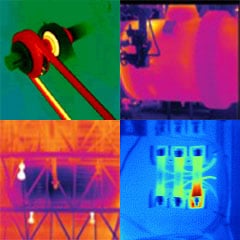Infrared Technology for Predictive Maintenance

Heat is a common indicator of abnormal equipment operations and is often indicative of premature failure. Inspecting equipment using infrared technology before there is a major problem will significantly reduce the premature failure and the costs associated with downtime.
Infrared Thermography provides a detailed photograph of each piece of operating equipment, indicating its “Heat Signature”. The amount of temperature rise over the normal operating temperature as well as an understanding of the equipment’s criticality to the operation, provides a good indicator of the severity of a problem. Typical applications include:
Electrical
equipment / systems to detect abnormal overheating from loose connections, corrosion, load imbalances, etc… in high and low voltage equipment.
Mechanical
systems to identify heat build-up associated with friction, misalignment or mechanical stress in equipment, including gear sets, pumps, motors and compressors
Energy Management
to locate areas of energy loss or gain to optimize insulation or design efficiencies (building envelopes, roof moisture surveys, boilers, chillers).
Process
applications to image and diagnose thermal patterns in industrial process equipment (presses, forming machines, welders, furnaces.)
Surveys are Performed:
- While equipment is operating and under full load.
- Using non-destructive testing that does not interrupt operations.
- Without contacting the target object.
- A safe distance from energized electrical equipment, rotating equipment, or equipment in hazardous locations.
DSI Solutions:
- 25 years of facility and equipment experience
- Design Systems hands-on engineering staff has the experience to define a solution after diagnosing the problem
- The Infrared survey can be performed in conjunction with the Conveyor and Equipment Health Assessments.
“BOTTOM-LINE” RESULTS:
- Reduce unplanned downtime
- Improve useful life of equipment
- Improve energy efficiency
- Reduce property damage and losses
- Establish repair priorities improving maintenance efficiency